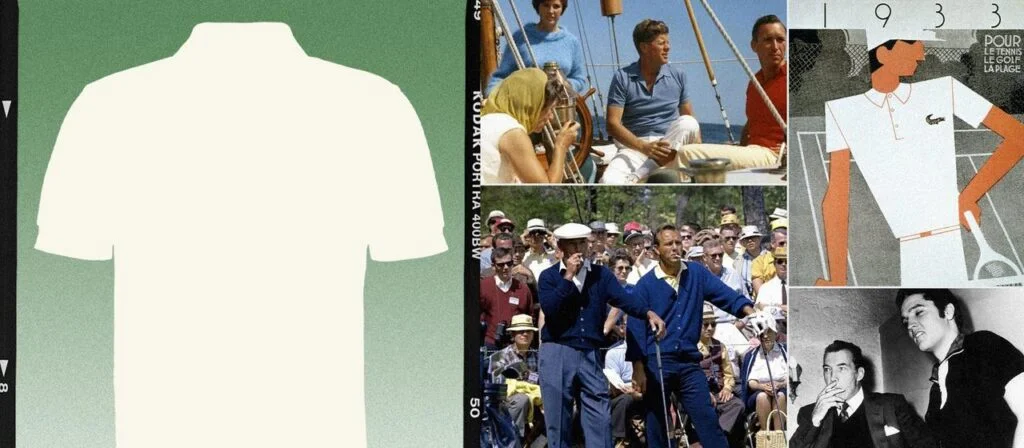The polo shirt is one of those timeless pieces of clothing that has transcended its origins to become a staple in almost every man’s wardrobe. Whether you’re dressing for a casual day out or a round of golf, the polo shirt hits the sweet spot between casual and polished. But how did this seemingly simple shirt rise to such iconic status?

From the tennis courts of the early 20th century to becoming a symbol of prep culture and luxury leisurewear, the history of the polo shirt is as versatile and fascinating as the garment itself. Let’s dive into how this classic shirt came to be and how it has managed to remain a fashion icon for more than a century.
1. The Tennis Roots: Enter René Lacoste
When most people think of the polo shirt, one name often comes to mind: René Lacoste. The French tennis champion didn’t invent the shirt per se, but he’s the one who took it from practical sportswear to an everyday style essential. Back in the 1920s, tennis players wore long-sleeved button-up shirts on the court—far from the most practical or comfortable attire for a high-energy sport.

Lacoste, nicknamed “The Crocodile” for his tenacious style of play, wasn’t satisfied with the standard uniform. So, he designed a short-sleeved shirt made of lightweight cotton piqué fabric, featuring a flat collar, a three-button placket, and an embroidered crocodile logo. His goal was to create something functional—breathable fabric, short sleeves, and a collar that could be turned up to protect the neck from the sun.
The shirt was an instant hit, and in 1933, Lacoste founded his eponymous brand, Lacoste, to start producing and selling the “tennis shirt” commercially. What began as a solution for on-court comfort quickly became an off-court fashion statement.
2. Polo’s Polo Shirt: The Influence of Polo Players
Interestingly, while the shirt was born on the tennis court, the name “polo shirt” comes from another sport altogether. Polo players in the late 19th century had been looking for something similar—a shirt that was more comfortable and breathable than the typical long-sleeved button-up shirts they’d been wearing while riding on horseback.

In fact, it was British polo players who first began wearing button-down collared shirts in the mid-1800s to keep their collars from flapping in the wind during matches. While the tennis shirt by Lacoste eventually took the name “polo shirt,” the association between this piece of clothing and the sport of polo was solidified when Ralph Lauren launched his iconic brand Polo Ralph Lauren in 1967. Lauren’s version of the polo shirt became an instant classic, known for its refinement and association with elite, preppy style.
3. The Ivy League and Preppy Boom
By the mid-20th century, the polo shirt had become a symbol of prep culture in the United States, especially on Ivy League campuses. Its simplicity, combined with its sporty origins, made it a staple for well-dressed young men who wanted to look polished but not overly formal.

The Ralph Lauren Polo shirt, with its instantly recognizable embroidered polo player logo, became a cornerstone of the preppy wardrobe, particularly in the 1980s. Lauren tapped into the aspirational lifestyle, and his brand turned the polo shirt into a status symbol—something that represented casual luxury, whether you were actually playing polo or just looking the part.
4. The Polo Shirt in Golf and Beyond
While tennis and polo laid the foundation for the shirt’s popularity, golf was the next sport to embrace the polo shirt fully. Golfers loved the ease of movement that the shirt provided, and its lightweight, breathable fabric made it perfect for long days on the course. Brands like Lacoste, Polo Ralph Lauren, Nike, and Callaway began producing specialized versions of the polo shirt for golfers, often incorporating performance fabrics designed to wick away sweat and provide UV protection.

Today, polos are as much a part of golf as the clubs themselves. The golf course further solidified the polo shirt as the ultimate “smart-casual” piece, perfect for occasions where a T-shirt is too casual but a dress shirt feels too formal.
5. From the 80s to Streetwear: The Polo’s Resurgence
The polo shirt continued to evolve through the late 20th century and into the 21st. In the 1980s, it became a part of hip-hop fashion, with brands like Lacoste and Polo Ralph Lauren being worn by influential artists like Kanye West, who famously rocked the pink polo during his early days. The polo became not just a preppy staple but also a symbol of street style, embraced by people from all walks of life.

More recently, high-end designers have reimagined the polo shirt as a luxury item, using premium materials like cashmere, silk blends, and fine cotton. Brands like Tom Ford, Brunello Cucinelli, and Gucci offer high-end versions of the polo, proving that it’s more than just a sportswear item—it’s a status symbol that fits seamlessly into both casual and more formal wardrobes.
6. The Modern Polo: A Timeless Classic
Today, the polo shirt is worn by everyone from athletes to celebrities to everyday men who appreciate its versatility. It’s found in a variety of contexts—whether it’s on the tennis court, the golf course, a summer party, or a casual office setting.

While the design has seen countless iterations—from long-sleeved versions to polos made of technical fabrics for performance sports—the basic concept remains the same. The polo shirt is the ultimate crossover between comfort and style. Its longevity in fashion is proof that great design never really goes out of style.
Final Thoughts
From its origins as a solution to restrictive sportswear to its rise as a symbol of casual sophistication, the polo shirt has earned its place as a wardrobe essential. Whether it’s the classic Lacoste tennis shirt, the preppy Polo Ralph Lauren, or modern designer takes on the style, the polo continues to evolve while staying true to its roots.

A symbol of effortless cool, the polo shirt has come a long way from the tennis courts of the 1920s. Its timeless appeal, versatility, and ability to be dressed up or down make it an enduring classic, and it’s not going anywhere anytime soon.



